This site is part of various affiliate programs. Links may give us a small compensation for any purchases you make, at no additional cost to you. Please read the disclaimer policy for full details.
So you got your hands on a Canon Rebel T6, and you are wondering which lenses you actually need?
I know how confusing this is when you are just starting out in photography. But worry not! This article should help you understand what the most popular lenses for this camera can do and which ones you might actually need.
The most important thing you need to understand is that lenses are far more important than the camera body. Most of the look and feel of your photos are the result of the lens and then the sensor. The best camera won’t be able to do much with a lousy lens attached to it.
This article will focus on the following best lenses for the Canon Rebel T6:
- Sigma 18-35mm F1.8 Art DC HSM
- Canon EF-S 24mm f/2.8 STM
- Canon EF 50mm f/1.8 STM
- Tamron AF 18-200mm F/3.5-6.3 Di-II VC
- Canon EF-S 55-250mm F4-5.6 IS STM
- Tamron 18-400mm f/3.5-6.3 DiII VC HLD
- Canon EF-S 10-18mm f/4.5-5.6 IS STM
- Canon EF-S 18-55mm f/3.5-5.6 IS II
- Canon EF-S 18-135mm f/3.5-5.6 IS
- Tokina ATX-i 100mm F2.8 FF Macro
The Best Lens for Canon Rebel T6 Today
The Best Canon Rebel T6 Lens
- Exceptionally sharp. It can easily replace prime lenses within that focal range
- f/1.8 throughout the whole zoom range
- Sturdy all-metal construction
- You can use it on a full-frame camera from 24mm onwards in a pinch – perfect if you upggrade your camera later
- Great bang for your buck
Comparison Table of Canon Rebel T6 Lenses
Lens | Closest Focus Distance | Autofocus Type | Image Stabilization | Check Price | |
28cm / 0.91ft | HSM | No | |||
16cm / 0.52ft | STM | No | |||
35cm / 1.15ft | STM | No | |||
49cm / 1.60ft | DC | Yes | |||
85cm / 2.78ft | STM | Yes | |||
45cm / 1.47ft | HLD | Yes | |||
22cm / 0.72ft | STM | Yes | |||
25cm / 0.82ft | Micromotor (linear) | Yes | |||
39cm / 1.27ft | STM | Yes | |||
30cm / 0.98ft | Linear | No |
How to Choose Your Canon Rebel T6 Lenses?
When you feel that you need a new lens, you need to know what are you looking for exactly.
There are plenty of lenses that you can fit on your camera, and by plenty I mean more than a hundred with all different manufacturers combined.
That means that you’ll need to do a little bit of research first, to find the right lens that fits your needs and budget.
Here are a handful of pointers for what you should look for when purchasing lenses in general, taken from my experience of Canon lenses and cameras.
Focal Length
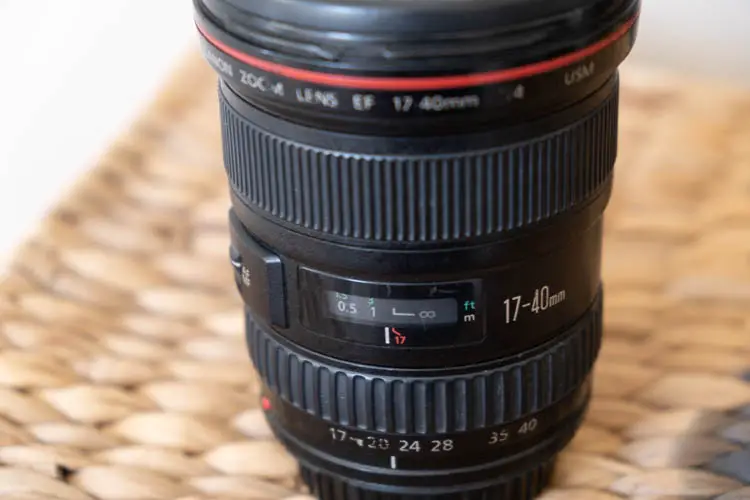
The lens focal length determines the angle of view of the lens. It is measured in mm, and the higher the length in mm, the further your lens can see.
The lower the mm, the more your lens can fit in the frame. So a wide angle lens, like the one in your smartphone, will be somewhere between 10mm and 35mm. While a telephoto lens, like the 20x zoom lens in your smartphone, will be somewhere in the range of 70mm to 300mm.
In other words, if you are standing in the same spot, with a 15mm lens you would be able to capture a whole soccer team, head to toe. And with a 200mm lens if you don’t move, you’ll be able to capture a close up portrait from one player.
Also, zoom lenses can have variable focal length, meaning that you can twist a ring to zoom in and change the focal length on the go. One famous example of this is the Canon 70-200mm f/2.8L IS III. That lens can go from 70mm to 200mm. That is quite useful if you don’t have the time to change lenses.
Aperture
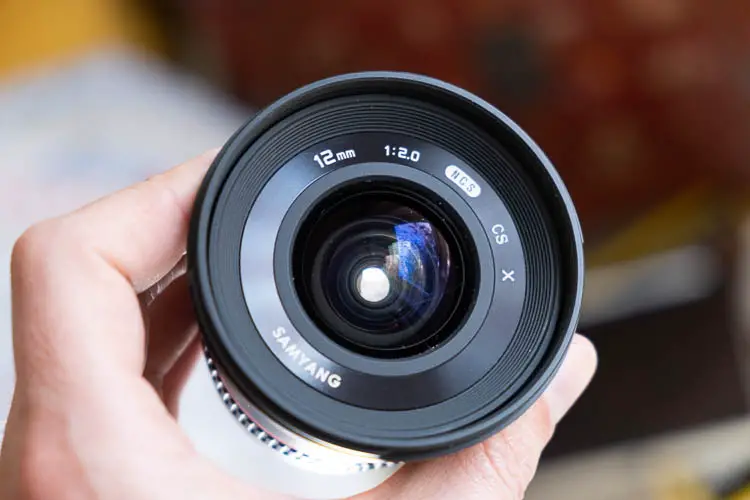
The amount of light the lens can capture is dictated mainly by the aperture. The smaller the aperture number, the more light it gathers. So an f/2 lens will gather twice as much light than an f/2.8 lens. An f/2.8 lens will gather twice as much light as an f/4 lens, and so forth. The aperture also determines the amount of background blur you can have. The wider aperture, the more background blur you will get.
Some zoom lenses have variable apertures. For example, Canon 100-400mm f/4.5-5.6L IS II will have variable aperture throughout the focal range. At 100mm, it will be f/4.5, and as you zoom in to 400mm, it will slowly creep up to f/5.6. For a complete explanation of why this is the case, read our article on f stop vs aperture.
Image Quality

Depending on the design and the cost, lenses differ in image quality. They differ in several areas: vignetting, chromatic aberration, sharpness, and color rendition. Lenses of higher quality have less vignetting, less chromatic aberration, and more accurate color rendition and they are incredibly sharp.
Autofocus Motor
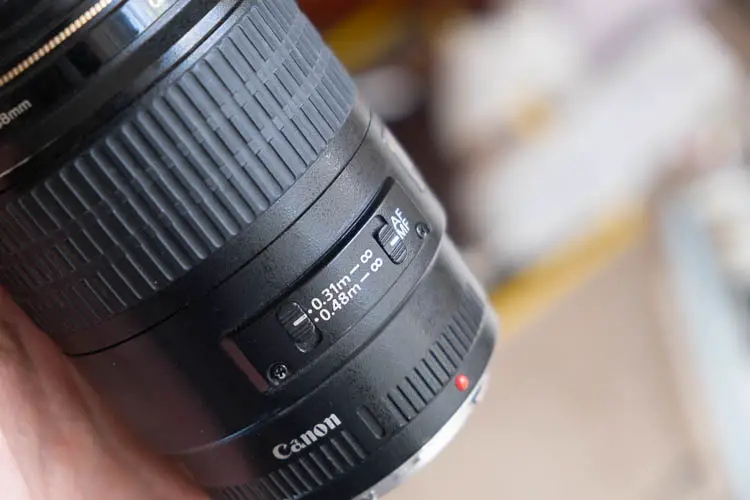
Lenses that aren’t manual have an autofocus motor driving the lens focus system. Not all autofocus motors are created equal. Usually, STM motors are more linear and quieter, and you’ll find those in the more budget options from Canon-made lenses, while USM motors will be the faster ones (also quite silent), usually found in higher-end Canon lenses.
Third-party manufacturers use the same motors as well but name them differently. For example, sigma calls their USM motor HSM, but essentially they are the same thing.
Rarely, especially in ultra-cheap lenses from Chinese manufacturers (and older Canon EF-S lenses), you will find linear motors. Those are loud, slow, and somewhat inaccurate. If you can, avoid lenses with motors like that. They just aren’t worth the hassle.
Image Stabilization
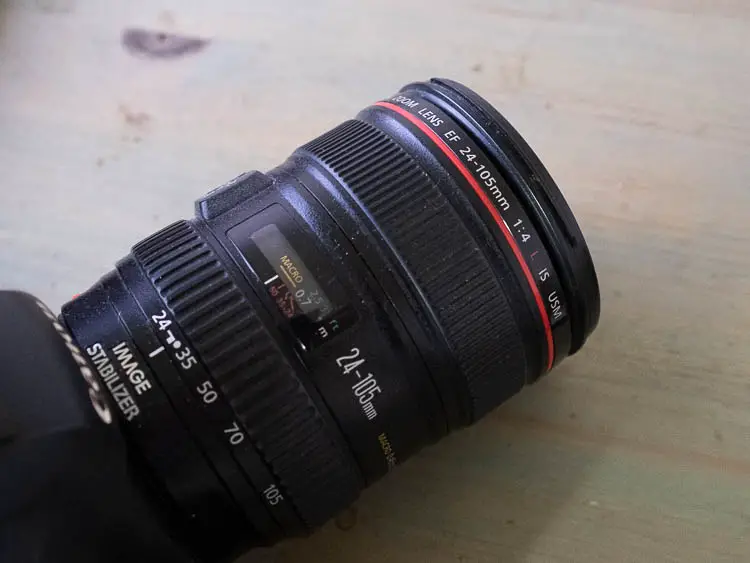
Some lenses feature electromagnetic image stabilization in them. This works by floating a set of lenses inside the lens, and that floating counteracts any camera shake that you might introduce. With that, you avoid having motion blur in your photos when you use slower shutter speeds.
With third-party manufacturers, image stabilization (IS for Canon lenses) will be named a bit differently. Sigma calls it Optical Stabilizer (OS), Tamron calls it Vibration Compensation (VC), and so forth. It is the same thing. From our experience, Canon’s own IS works the best compared to others. Nevertheless, any form of image stabilization is always welcome.
Filter Size/Thread
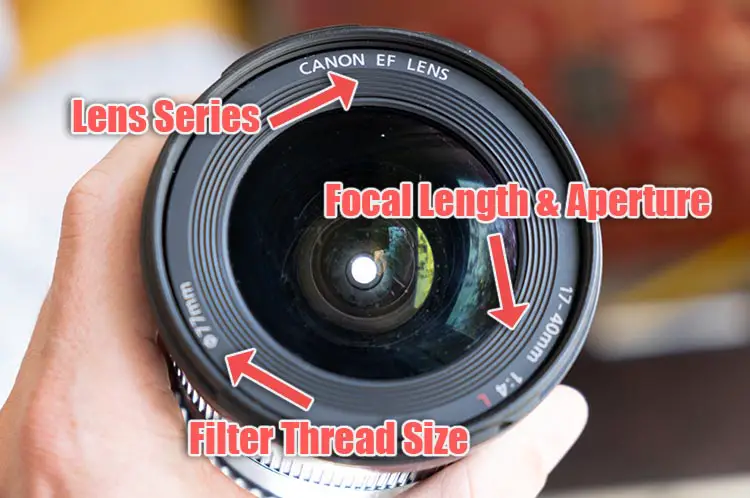
99% of the lenses can take screw-on filters on the front lens element. If you take a look at any lens you have around, you’ll notice that around the front glass element there is a thread on the body of the lens. That thread is where you screw-on lens filters. Different lenses have different thread diameters, so if you plan on purchasing filters for your lenses, be mindful of the diameter of the filter thread.
Pro tip: if you own multiple lenses, get a filter for the lens with the largest diameter, and then get step-up rings to fit that filter to the smaller filter threads. That way, you purchase one filter and a cheap piece of metal that will allow you to mount it on all your lenses. Buying separate filters for all of your lenses can cost you a fortune.
Minimum Focus Distance
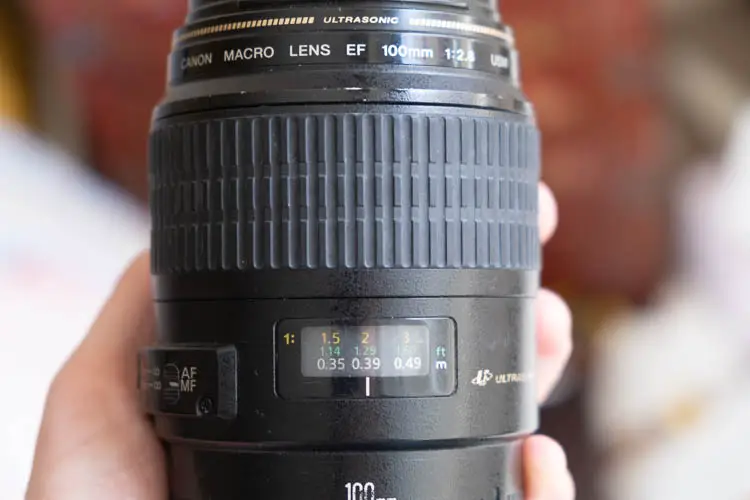
Each lens has a minimum focus distance. In other words, you are limited on how close you can get to your subject. Regular lenses top out at around 50-80cm, while macro lenses will allow you to get as close as 5cm to your subject. That way, small subjects can fill the frame easily.
If a macro lens is too expensive for you, you can use either a diopter filter to reduce the minimum focus distance or extension tubes. The former come at the cost of image sharpness, and the latter comes at the cost of reduced light output. Macro lenses suffer from neither of those; hence they cost more.
Build Quality and Weather Sealing
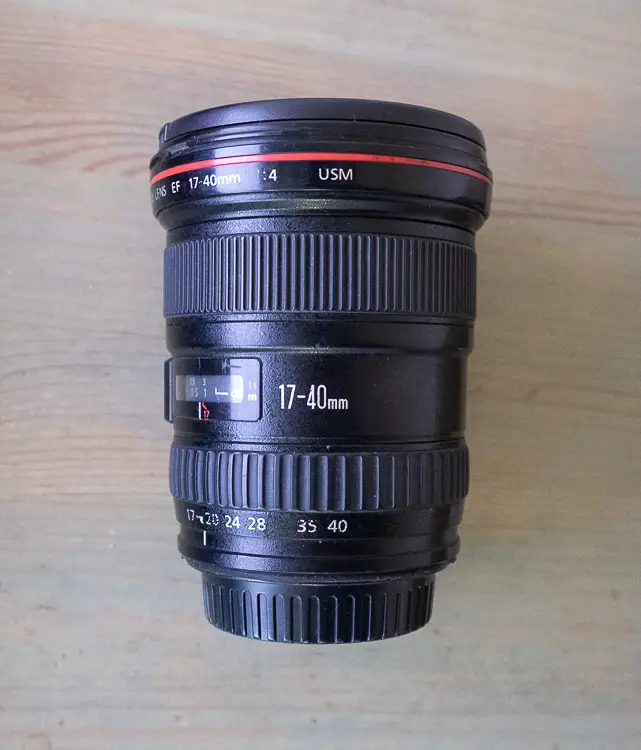
Not all lenses are created equal. Some lenses have better build quality than others, and you can notice that by holding the lens in your hand. Better-built lenses have little to no rattling, focus, and zoom rings move nice and smooth and have no play. Materials feel premium in hand and so forth.
Some lenses are weather sealed, meaning that they can resist rain and dust. These are usually much more expensive.
Reviews of the Best Canon Lenses for the Rebel T6
Now that you know what to look for when choosing lenses let’s make that even easier for you by reviewing the ten most popular lenses for your camera.
Bear in mind that we update this list on a regular basis, so make sure you check in once in a while. You might find a lens or two that previously wasn’t here.
1. Sigma 18-35mm f/1.8 DC HSM Art [Best Lens for Canon Rebel T6]
Specifications:
- Mount: EF Mount, but intended for crop sensor bodies
- Closest Focusing Distance: 28cm / 0.91ft
- Maximum Magnification: 0.23x
- Autofocus Type: HSM
- Image Stabilization: No
- Filter Thread: 72mm
There are times when manufacturers need to stand out in the market, and they release a product that pushes the boundaries. This lens does just that, being the first zoom lens for the Canon Rebel T6 with a constant f/1.8 aperture and being sharp as prime lenses at that aperture. Neat!
Image Quality
This high end lens from Sigma is among the sharpest, if not the sharpest, zoom lens ever made for a crop camera. It is also the brightest zoom lens ever made for a crop camera.
The lens is sharper at 18mm and loses sharpness slightly at 35mm. You won’t notice the difference since it is incredibly sharp from the get-go. The lens is sharpest somewhere between f/2 and f/2.8, but the difference in sharpness between f/1.8 and f/2.8 is barely noticeable. That is an excellent feature to have.
The lens has little to no chromatic aberration in high contrast areas but presents some chromatic aberration in the out-of-focus areas if you focus near the minimum focus distance.
You will notice that the vignette is well controlled at -1EV, and so is the distortion. There is hardly any flare or ghosting that is exceptionally well controlled.
Out-of-focus areas are very well rendered. The bokeh balls aren’t too sharp which provides for a buttery smooth blur. Add to that very good color rendition with good contrast, which renders nice and punchy images that pop.
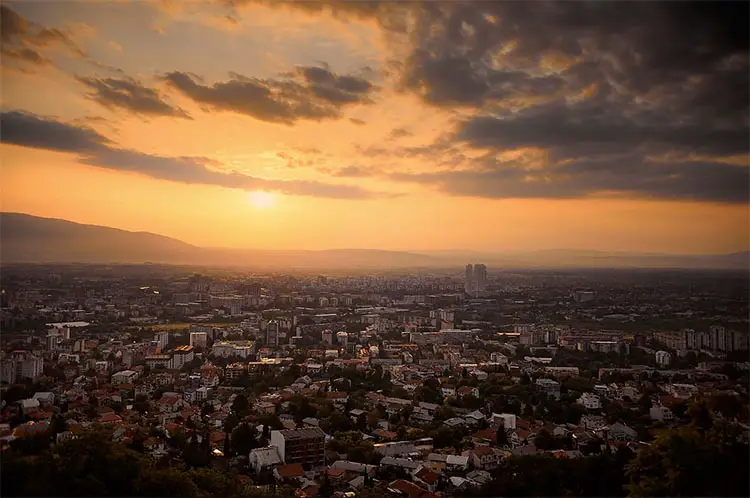
Build Quality
Even though this is a pro-grade lens made by Sigma, you won’t find image stabilization here. And you shouldn’t expect it. To produce a constant aperture of f/1.8, the lens elements are quite heavy, and a design with OS will just increase the already hefty weight.
The lens, however, is built like a tank. It is made mainly from metal all around, with some high-quality proprietary plastic alloys where needed. Sadly, there is no weather sealing. It is a bit heavy, weighing in at 810 grams. But it is well balanced even though it is around 12cm long.
Focusing with this lens is quick and snappy. However, the accuracy will significantly depend on the camera body you have. Cameras with simpler autofocus systems like the T6 have fewer issues, while cameras with more complex autofocus systems like the 7D Mark II have more issues.

Generally, the lens is quite accurate at portrait distances and loses accuracy when focusing towards infinity. That inherently makes it harder to focus on the wide end of the lens. But you shouldn’t have too many problems with the T6.
Who is the Sigma 18-35mm f/1.8 DC HSM Art lens for?
A lens like this should be in the backpack of every photographer that shoots an APS-C body and can afford the $610 price tag. It replaces an 18mm, a 24mm, a 28mm, and a 35mm prime lens, all in one single package.
It is probably the best deal out there.
- Pros:
- Exceptionally sharp all across the board.
- Wide f/1.8 aperture at every zoom level.
- Great value for money.
- Sturdy all metal construction.
- Fast and reasonably accurate autofocus.
- You can use it on a full-frame camera if you ever upgrade, with a limited range from 24 to 35mm.
- Cons:
- No weather sealing.
- No image stabilization.
- Can feel heavy when mounted on a light camera body.
2. Canon EF-S 24mm f/2.8 STM
Specifications:
- Mount: EF-S Mount
- Closest Focusing Distance: 16cm / 0.52ft
- Maximum Magnification: 0.27x
- Autofocus Type: STM
- Image Stabilization: No
- Filter Thread: 52mm
Image Quality
The 24mm f/2.8 STM is a quite sharp little lens. At f/2.8, it is pretty sharp in the center, and the sharpness falls off slightly in the corners, which is to be expected from a lens this small. Stop it down to f/4, and the corner sharpness improves slightly.
If you stop the lens down even further, you will start noticing the loss of sharpness due to diffraction. Usually, diffraction kicks in after f/8, but since this is a pancake lens, the optical design is more prone to diffraction.
Surprisingly there is very little chromatic aberration present in this lens, meaning that what’s left can be easily removed in post production without harming the details. That being said, there is around a -1.5EV vignette present, which is not too bad, but not great either. It can also be corrected in post production.
Just like the CA and vignetting, there is a little barrel distortion present, but nothing significant. That can also be corrected in post production.
There is some flaring and ghosting present, unsurprising for lenses of this size and price. Still, it is not too much, and it won’t hinder your photos in 99% of the cases.
The color and contrast rendition is where you start to see the low price tag of this lens. They aren’t the worst, yet, you’ll notice that the photos look a bit flat, and they lack punch and pop. If you fiddle with it a bit, you can fix this in post-production, but it can be a nuisance.
Build Quality
The build quality of the lens is fairly decent. It has a metal mount and a plastic “barrel”. The build quality standard is akin to the kit lenses, which aren’t built like tanks. You can’t expect more from a lens that costs $150. Bear in mind that there is no weather sealing, so water is your enemy here.
Even though the lens is almost entirely made from plastic, Canon uses high-quality plastics that are durable. Make no mistake, if you take care of this lens, it will last for years.
The STM autofocus is quick and quiet, not as quick as USM would be, but USM focus motors can’t fit in a lens this small.
Weighing in just 125g and protruding just 2.3cm from the camera justifies the “pancake” nickname. It is a low-profile lens that is as compact as it gets. Great for walking around and street photography. It reduces the footprint of a DSLR camera significantly.
Who is the Canon EF-S 24mm f/2.8 STM for?
If you want a small, compact, ultra-lightweight and cheap lens that will have around 35mm equivalent focal length, then this is the perfect lens for you.
- Pros:
- Great image quality.
- Extremely light and compact pancake design.
- Decent STM focusing motor.
- Very affordable at just $150.
- Cons:
- No weather sealing.
- No image stabilization.
- Colors and contrast can be a bit flat.
3. Canon EF 50mm f/1.8 STM
Specifications:
- Mount: EF Mount
- Closest Focusing Distance: 35cm / 1.15ft
- Maximum Magnification: 0.21x
- Autofocus Type: STM
- Image Stabilization: No
- Filter Thread: 49mm
Image Quality
Being an affordable entry-level full-frame lens, one would expect severe compromises in image quality. However, the 50mm f/1.8 STM is plenty sharp and wide open in the center, even if the corners are a little soft.
By f/5.6, overall sharpness increases slightly in the center of the lens, and it increases significantly in the corners. Thus bringing the corners and the center of the lens closer together in sharpness.
After f/11, you will notice the effects of diffraction kicking in and the lens losing sharpness.

There is around a -2.5EV vignette in the extreme corners, which worsens at f/2 to -3EV, clears up at f/4 to -0.8EV, and stays there throughout the rest of the aperture settings.
Chromatic aberration is well controlled for a lens of this price point, and the little CA that is present can be easily removed in post production. The same goes for distortion. There is little present, but nothing that will bother you. You can remove that in post production as well.
There is some flaring and ghosting, but depending on your style, you might like it. It isn’t too intrusive, but it adds a bit of character to the photos, and this is aided by the great color and contrast rendition.

Bear in mind most of the issues that affect the corners are primarily visible on a full-frame camera. The T6 is a crop sensor camera; thus, it avoids the weaker parts of the image circle. So the -3EV vignette on a crop sensor is closer to -1EV, which is excellent.
For a cheap lens, it renders out-of-focus areas quite nicely.
Build Quality
The first iteration of this lens, which had the linear focus motor and a plastic mount, was named “Plastic Fantastic” for a reason. However, this revision improves the build quality by using a metal mount and more fantastic plastic. It is still an entry-level camera lens, so don’t expect weather sealing or high-end build quality.
Unlike the older version of the lens, there is no rattling here, everything fits nice and snug, and the STM motor is decently fast. The focus accuracy can be better, but it is improved over the older variant. The focus accuracy decreases on longer distances, so it is quite good if you use it for portraiture. When it misfocuses, it is usually on the infinity end.
Weighing in at 160g, and protruding only 4cm, you can barely feel the weight difference. It is compact and easy to handle, which is always a plus.

Who is the Canon EF 50mm f/1.8 STM for?
Aspiring photographers getting into low light and portrait work should use this 50mm lens. It is cheap, so it will fit almost any budget.
- Pros:
- Extremely light and compact design.
- Great image quality.
- Decent STM focusing motor.
- Very affordable at just $130.
- Nice background blur.
- Wide aperture at f/1.8.
- Cons:
- No weather sealing.
- No image stabilization.
- Focus can be inaccurate when focusing near infinity.
Read More:
4. Tamron 18-200mm f/3.5-6.3 Di II VC [Zoom Lens for Canon Rebel T6]
Specifications:
- Mount: EF Mount, but intended for crop sensor bodies
- Closest Focusing Distance: 49cm / 1.60ft
- Maximum Magnification: 0.25x
- Autofocus Type: DC
- Image Stabilization: Yes
- Filter Thread: 62mm
Image Quality
The Tamron 18-200mm is a superzoom lens since it can zoom in more than 10x. With that zoom range often come sacrifices. The sacrifices, in this case, are in the overall sharpness and the maximum aperture.
At the wide end, the lens is reasonably sharp in the center. As you zoom in, you lose some sharpness, and then you start gaining some sharpness as you reach the telephoto end. That is expected.
Chromatic aberration is fairly well controlled in the 24 to 100mm range, but it is noticeable in the widest, and most telephoto ends. The same applies for vignette as well. There is some distortion present at all ranges, but that is also correctable in post-production.
Overall, the image quality is decent for a lens with this zoom range at this low price point.
Build Quality
Most of the lens is made from plastic. There are some metal parts here and there, but nothing substantial. The lens is partially weather sealed, meaning it can resist some moisture, but don’t expect it to work in heavy rain. If nothing else, the weather sealing gasket on the lens mount should prevent water from getting into the camera.
The autofocus uses a DC motor, which is old technology. It is slow and loud. However, it is the quietest DC motor focusing lens out there, so there is that. The focus accuracy is decent. Most of the pictures are in focus.
At 200mm, it is hard to keep any lens steady and avoid motion blur. Luckily the Vibration Compensation works quite well and removes most of the camera shake you introduce. You still have to be a bit patient to avoid overwhelming the VC and still get motion blur in your shots.
Who is the Tamron 18-200mm f/3.5-6.3 Di II VC for?
If you are looking to cover most of the focal lengths in a single and cheap lens, this is the right lens for the job. Ranging from 18mm to 200mm, decently sharp with VC and for $250, and it is a steal.
- Pros:
- Great zoom range.
- Lightweight.
- Partially weather sealed.
- It has image stabilization.
- Fairly sharp for a cheap superzoom.
- Cons:
- Old DC focus motor, which is loud.
5. Canon 55-250mm f/4-5.6 IS STM
Specifications:
- Mount: EF-S
- Closest Focusing Distance: 85cm / 2.78ft
- Maximum Magnification: 0.29x
- Autofocus Type: STM
- Image Stabilization: Yes
- Filter Thread: 58mm
Image Quality
The EF-S 55-250mm is probably the sharpest budget telephoto lens that you can get for crop cameras like the Canon Rebel T6, made by Canon.
Of course, being a budget lens, there will be a compromise regarding image quality and features, but it is not that big of a compromise.
Previous versions of this lens were soft the more you zoomed in. However, this lens is quite sharp for what it is, and the results are quite useful. It won’t be as sharp as L glass, but it costs ten times less than that, so there is that.

The lens is sharpest at f8, where it loses pretty much all of the -1.5EV vignette it has, and most of the slight chromatic aberration visible is corrected too. This lens performs reasonably well in terms of CA, vignette, and distortion. All of these defects can be easily fixed in Lightroom, just turning on profile corrections.
You will find that there is some flaring and ghosting present in this lens, but it is not a huge issue. You might end up liking it. Colors and contrast are fairly decent. They can be better, but you almost avoid that “cheap glass look” that most cheap lenses produce.
Build Quality
You wouldn’t be surprised if I told you that most of these lenses are made from plastic. Everything you see, except the glass elements, is made from plastic. Even the mount itself is plastic. However, the plastic used isn’t the worse. In fact, it is quite good. Sadly, they didn’t include a metal mount, at least.
The image stabilization on this lens is rated at 3.5 stops according to CIPA, which for a budget lens, is great. That means if you were to shoot something at 1/1000th of a second, you could safely shoot it at around 1/100th of a second without motion blur induced by a camera shake.
Focusing this lens is a breeze, thanks to the STM motor. It is slower than the USM focus motor, but it is quite a bit faster than the old DC/Linear motor the previous generations had.

The focusing is quite accurate, and the narrow aperture aids with that significantly. There is a full-time manual focus override, but you can manually focus the lens only if the camera is powered on, since the lens uses focus by wire mechanism.
Overall it fits nicely in hand, and it is not heavy at all, weighing only 375g. I guess the plastic build has its perks. There is no weather sealing, nor can you expect it from a lens at this price point.
Who is the Canon EF-S 55-250mm f/4-5.6 IS STM for?
If you need to extend the reach of your 18-55mm kit lens, this is the perfect addition to it. It will produce pretty much the same colors and image quality as the kit lens (albeit a little sharper), and with two lenses, you’ll cover most of the useable focal range. You can shoot the moon with this lens as well.
- Pros:
- Long telephoto zoom range.
- Good image quality.
- Has good image stabilization.
- Lightweight.
- Fairly cheap.
- Nice and accurate autofocus.
- Cons:
- The body is made entirely out of plastic.
- No weather sealing.
6. Tamron 18-400mm f/3.5-6.3 Di II VC HLD [Telephoto Lens for Canon Rebel T6]
Specifications:
- Mount: EF Mount, but intended for crop sensor bodies
- Closest Focusing Distance: 45cm / 1.47ft
- Maximum Magnification: 0.34x
- Autofocus Type: HLD
- Image Stabilization: Yes
- Filter Thread: 72mm
Image Quality
Like any superzoom, you are sacrificing some image quality for the zoom amount you get. In this case, you have around 22x zoom, going from 18mm all the way to 400mm.
Luckily, this is a bit more of an advanced superzoom, so the image quality is decent for the zoom range. Of course, the more you zoom in, the more sharpness you lose, but even at 400, the sharpness is okay.
The corners suffer from sharpness loss, which is to be expected, but they recover if you stop down the lens to f/8. Stopping the lens further than that introduces diffraction sharpness loss. So there is a fairly small window of apertures you have to choose before you start losing sharpness.
Chromatic aberration is well controlled, and most, if not all of the CA you manage to see can be removed in post-processing. There is some chromatic aberration in the out-of-focus areas, which increases as you stop down the lens, which is odd. Most of the chromatic aberration you’ll see will be towards the 400mm end.
Distortion isn’t well controlled in this lens, and it goes all over the place. It starts as barrel distortion towards the 18mm range, flips into significant pincushion distortion in the 35-50mm range, and it starts to go back to acceptable levels in the 200 to 400mm range. Most of it can be corrected in post-production, but you might end up cropping 10-15% of your image in the process.
Vignetting is well controlled at -1.5EV, and it is pretty much gone when you stop down to f/8.
Flaring and ghosting can be a problem for some. Since the lens is quite complex with 16 elements in 11 groups, there is plenty of glass for the light to bounce from, and thus you will be getting some flaring and ghosting. Especially when you zoom in, there are instances where the whole image will be washed out, so it’s recommended that you always use a lens hood to prevent lens flare.
Contrast and color renditions are somewhat better than the kit lenses, but whenever you have the light in the frame, the lens flare and glare produce that cheap lens look.
The lens isn’t focally consistent. In other words, it is 400mm only when you focus on infinity. If you focus on closer subjects, the lens zooms out to something near 300mm. That is not good.
Build Quality
The lens is mostly made from high-quality plastic, on a metal mount with a rubber gasket around it. That means that the lens is at least partially weather sealed. The zoom ring moves smoothly with a bit more resistance towards the ends of the range.
The image stabilizer, or vibration compensation as Tamron likes to call it, certainly helps with the longer focal ranges of the lens. It is not class-leading, and it can be better, but a mediocre VC is better than no VC at all. Especially when the lens closes down to f/6.3 on the far end.
On the other hand, autofocus is nice and smooth. Some users report focus inaccuracy, which needs calibration via the Tap-in device (basically a lens dock). So with some fiddling, the autofocus can be tuned to perfection. Problem is, not everybody wants to fiddle with a newly purchased lens, and that is something Tamron’s quality control should have resolved.
Remember that even though this lens looks like the perfect travel all-in-one lens, it might be a bit cumbersome to take with you. It weighs around 710g. In other words, it weighs approximately 45% more than the Rebel T6.
Who is the Tamron 18-400mm f/3.5-6.3 Di II VC HLD for?
The lens is aimed for photographers that completely dislike changing lenses, and they would rather lug a heavier lens around instead of swapping a lens out. And their budget will support paying $700 for that experience.
- Pros:
- Decent image quality for that focal range.
- Extremely long zoom range, at 22x zoom.
- Decent build quality.
- Partial weather sealing.
- Image stabilizer.
- Cons:
- Heavy.
- A bit costly.
- Autofocus might need calibrating by the user.
- Image zooms out when focusing on closer subjects.
7. Canon EF-S 10-18mm f/4.5-5.6 IS STM [Wide Angle Lens for Canon Rebel T6]
Specifications:
- Mount: EF-S Mount
- Closest Focusing Distance: 22cm / 0.72ft
- Maximum Magnification: 0.15x
- Autofocus Type: STM
- Image Stabilization: Yes
- Filter Thread: 67mm
As you may have noticed, the EF-S 10-18mm, EF-S 18-55mm, and the EF-S 55-250mm are all designed to complement each other. In other words, Canon covered most of the focal lengths in three affordable zoom lenses.
Image Quality
Being a lens designed to extend the kit lens range, one doesn’t often expect much of the lens. That being said, the lens is actually quite good image quality-wise.
It is relatively sharp in the center of the frame, with some sharpness loss towards the corners. You will get a moderate sharpness increase if you stop the lens down to f/8, though. After that, the effects of diffraction will kick in.
Vignetting is well controlled at around -1.4EV when the lens is wide open and at the widest focal length. Stopping down to f/8 reduces the vignette to around -0.5EV, which is great.
Chromatic aberration is probably the weakest side of this lens optics-wise. There is chromatic aberration present at pretty much any focal length, and it is reduced as you stop down the lens. Luckily it is not too bad, and you can remove most if not all of it via profile corrections in post-production.
There is some distortion present, especially on the wide end of the lens, but it is not too bad.
There is some flaring present, and it is quite visible. However, the flare looks something akin to the kit lens flare instead of an artistic one that some photographers might want to embrace.
Colors and contrast are average. If you aren’t careful with the sun position, you will get a cheap lens look, which is not good.
Build Quality
The lens is entirely made from plastic. Luckily, Canon always uses quality plastics for the lens, so it doesn’t feel like it will fall apart in the hand. Even the mount is made from plastic. That also means there is no weather sealing, and one can’t expect that from a $300 lens.
There is image stabilization, however, and it works great. It removes around 4 stops of camera shake, and it works great for video too.
The autofocus is nice and accurate. Canon’s STM focus motors work really well on lightweight lenses like this one. Even though they aren’t as fast as the USM counterparts, they are plenty fast.
With a wide-angle lens, the elements don’t have to move much to achieve focus, meaning that you won’t ever feel like you are waiting for the autofocus to catch up. Of course, being a wide-angle lens means that you already have plenty of things in focus, which contributes to accurate autofocus.
Overall, the lens is quite light, weighing in at just 240g.
Who is the Canon EF-S 10-18mm f/4.5-5.6 IS STM for?
Aspiring landscape photographers, photographers who want to expand the kit lens capabilities towards the wide angle, and generally photographers that want a quality wide angle lens for the Canon Rebel T6 for $300 or less.
- Pros:
- Good image quality.
- Quite an affordable wide-angle zoom lens.
- It has image stabilization.
- Quite lightweight.
- Fast and accurate autofocus.
- Cons:
- No weather sealing.
- Poor flare control.
- Some chromatic aberration is present.
8. Canon EF-S 18-55mm f/3.5-5.6 IS II
Specifications:
- Mount: EF-S Mount
- Closest Focusing Distance: 25cm / 0.82ft
- Maximum Magnification: 0.36x
- Autofocus Type: Micromotor (linear)
- Image Stabilization: Yes
- Filter Thread: 58mm
Image Quality
The 18-55mm lens is probably the most common lens you can find for Canon. It is the kit lens for most APS-C cameras. Being a kit lens, one can’t expect groundbreaking performance. The question now is whether it is worth using/getting?
The lens is reasonably sharp, being the sharpest between 24mm and 35mm. It tends to lose sharpness when it is completely zoomed in or zoomed out.
Corners don’t suffer too much from sharpness loss. However, if you pixel peeps, you’ll notice some sharpness loss in the corners. It is not a problem for most applications.
From 18mm to 35mm-ish, the lens is sharpest at f/5.6, while when zoomed in to 55mm, you achieve peak sharpness at f/8.
There is a -1.5EV vignette at 18mm when wide open, and that vignette slowly goes away as you zoom in or stop down the lens.
You will notice distortion at 18mm, which slowly corrects itself as you zoom in. The same applies to chromatic aberration. There is some CA visible at 18mm, but it corrects itself as you zoom in or close down the lens.
The colors are okay, and they work well as long as there is no direct light source in the frame. Then you notice some flaring. The amount of flare isn’t much, but it looks cheap. Pair the cheap-looking flare with the lens’s inability to handle direct light, and you are getting the cheap lens look. Sadly, these kit lenses are where that “look” originates.
Build Quality
The lens, being a kit lens, is entirely made from plastic. This is both a cost and weight-saving measure. Even though it is plastic built, these lenses are fairly durable due to their simple design. There is no weather sealing of course.
The image stabilization works quite well, though. It partially makes up for the narrow apertures present on this lens. It will correct around 4 stops worth of camera shake.
Autofocusing with this lens will be effective, albeit a bit loud. It uses the old linear micromotors, so there will be a bit of noise. It is not the fastest one as well. However, it is quite accurate.
Weighing in at 200g and being quite a small size, it is the perfect everyday lens for the small APS-C cameras. That is probably the reason why Canon makes it the kit lens for most of the APS-C cameras. Especially the smaller entry-level ones.
Who is the Canon EF-S 18-55mm f/3.5-5.6 IS II lens for?
Being the kit lens, chances are most people that got an entry-level DSLR from Canon already own it. Yet, it is a great lens for people looking for a simple, light, everyday lens that doesn’t cost a fortune.
- Pros:
- Better than average image quality.
- Affordable.
- Comes as a kit with many APS-C cameras.
- Has image stabilization.
- Cons:
- Flare and color control is mediocre at best.
- No weather sealing.
9. Canon EF-S 18-135mm f/3.5-5.6 IS STM
Specifications:
- Mount: EF-S Mount
- Closest Focusing Distance: 39cm / 1.27ft
- Maximum Magnification: 0.28x
- Autofocus Type: STM
- Image Stabilization: Yes
- Filter Thread: 67mm
Image Quality
The EF-S 18-135mm f/3.5-5.6 IS STM can usually be found as a kit with the higher-end APS-C DSLRs from Canon. This often means that it should be a bit higher quality optically than the cheaper and simpler 18-55mm. That is partially true. With the increased zoom range comes a more complex optical formula.
That brings us to the sharpness profile of the lens. If you were to shoot this lens and constantly zoom in, you’d notice that the lens isn’t consistently sharp.
It is fairly sharp at 18mm up to 35mm, but at 35mm, there is a significant sharpness drop, which corrects as long as you get near 50mm, and then it drops again significantly at 85mm, and it starts correcting itself as you move away from 85mm. That is true regardless of the aperture.
The 35mm dip in sharpness is corrected if you stop down to f/5.6, which isn’t so bad. However, to correct the dip in sharpness at 85mm, you’ll have to drop down to f/11.
Vignetting is well controlled, at -1.3EV on the wide end and -1EV on the telephoto end when wide open. Stopping the lens down to f/5.6 will remove most of the vignette up to 85mm, from where you’ll have to stop down to f/8 to remove most of the vignette from 85mm to 135mm.
Distortion is well corrected with the exception of 18mm, where you can see a noticeable amount of barrel distortion. There is some pincushion distortion on the rest of the focal range, but it is hardly noticeable and easily corrected.
There is some chromatic aberration present, especially at the very ends of the focal range (18mm and 135mm), but it is more noticeable in the corners. This is corrected when closing down the aperture.
Color and contrast-wise, it is somewhat improved over the 18-55, with the colors looking a bit better. You will notice that lens flare is also a bit better corrected and doesn’t look cheap.
Build Quality
If you hold all of the Canon budget lenses, the 10-18mm, 18-55mm, and 55-250mm, you’ll notice that this lens is a bit better built than those. It features a metal mount, and the plastics feel a bit sturdier, more akin to the 55-250mm, rather than the 18-55mm. You will also notice that it is heavier, weighing around 480g. So it feels a bit denser than the others.
The image stabilization is great. You will be getting around 4 stops of shake removal. The IS is also decently tuned for video work, so you won’t get many skipping and weird frame jumps.
Moreover, the STM autofocus works great. It is fast and quiet, which confirms that the STM motors were a great addition to the kit lenses that Canon makes. You’ll find that the lens focuses fairly accurately, and it won’t miss many shots.
All in all, it is a bit heavier lens than the other lenses in the class, but it feels good and balanced in the hand. It does the job perfectly.
Who is the Canon EF-S 18-135mm f/3.5-5.6 IS STM for?
Photographers that want a bit fancier kit lens and run-and-gun videographers will benefit quite a lot from this lens and the IS it has.
- Pros:
- Decent image quality.
- Good focal range with ~7.5x zoom.
- Decent flare and vignette control.
- Has great image stabilization.
- Autofocus works well and focuses accurately.
- Cons:
- No weather sealing.
- A bit heavier than expected.
- Weird sharpness loss at 35mm and 85mm.
10. Tokina ATX-i 100mm f/2.8 FF Macro [Macro Lens for Canon Rebel T6]
Specifications:
- Mount: EF Mount
- Closest Focusing Distance: 30cm / 0.98ft
- Maximum Magnification: 1x
- Autofocus Type: Linear
- Image Stabilization: No
- Filter Thread: 55mm
Image Quality
Being the only full frame and macro offering on this list, the Tokina ATX-i 100mm f/2.8 FF Macro is quite a sharp macro lens for the Canon Rebel T6. Sharpness is well preserved across the frame, with slight dips in sharpness in the extreme corners. Closing down the lens increases sharpness marginally, with the sharpest aperture being f/5.6. The lens is perfectly sharp at f/2.8 too.
Vignetting is very well controlled, with almost unnoticeable -0.8EV of vignette present when wide open. On an APS-C camera, wide open, it shouldn’t display a noticeable vignette. At f/5.6, the vignette drops to -0.5EV, which for the T6 would be around -0.2EV. In other words, the vignette is not an issue.
Chromatic aberration, on the other hand, is minimally present, but it can be corrected completely without any detail loss.
Colors are nice and rich, a bit different from what you’d expect of a Canon lens, but gorgeous none the less. Contrast is nice and punchy. Something you’d expect from a premium lens. And yet this one costs just $399.
Build Quality
The lens is a plastic build on a metal mount. The plastics feel decent, but compared to other manufacturers they can be seen as a bit cheap. There is no weather sealing, nor should it be expected from a lens with excellent optical quality, priced at just $399.
When focusing to the closest focal distance the front element extrudes around twice the length of the lens. Meaning that when you are shooting macro, the lens extends and becomes twice as long. It is great that you have around 30cm to the subject when you are at 1:1 magnification. This makes lighting subjects up a bit easier.
The autofocus is fairly accurate, it can miss from time to time, but you can’t expect much from a third party manufacturer with a focus motor that is linear and slow.
There is a clutch mechanism to throw the lens in manual focus mode, by basically moving the focus ring back and forth. When the lens is in manual focus mode you can rotate the focus ring, so fine and precise manual focusing shouldn’t be a problem.
Who is the Tokina ATX-i 100mm f/2.8 Macro for?
Aspiring macro photographers that don’t want to fiddle with extension tubes or diopters will find great value in this lens. It is bright, sharp, and can reproduce 1:1 macro shots, and all that for $399.
- Pros:
- Bright f/2.8 aperture.
- A quite sharp corner to corner.
- Great 1x magnification for macro work.
- Good working distance of 30cm for macro work.
- Affordable.
- Cons:
- Build quality is a bit cheap.
- The Autofocus motor is a bit outdated.
Final Thoughts on Which is the Best Lens for the Canon Rebel T6
There are plenty of lenses that you can fit on a Canon Rebel T6, however, there aren’t many lenses like the Sigma 18-35mm, or the Tokina 100mm f/2.8 macro. At least not for those price points. Lenses like that should find their way into every photographer’s bag.
Or, lenses like the Tamron 18-400mm, even though a bit soft when compared to primes, should find their way into the hands of photographers that want an all-in-one solution.
Really it depends on the types of photography that you enjoy, but for a complete lens solution that should cover you for everything, then the ideal choices are:
The Best Canon Rebel T6 Lens
- Exceptionally sharp. It can easily replace prime lenses within that focal range
- f/1.8 throughout the whole zoom range
- Sturdy all-metal construction
- You can use it on a full-frame camera from 24mm onwards in a pinch – perfect if you upggrade your camera later
- Great bang for your buck
Read More:
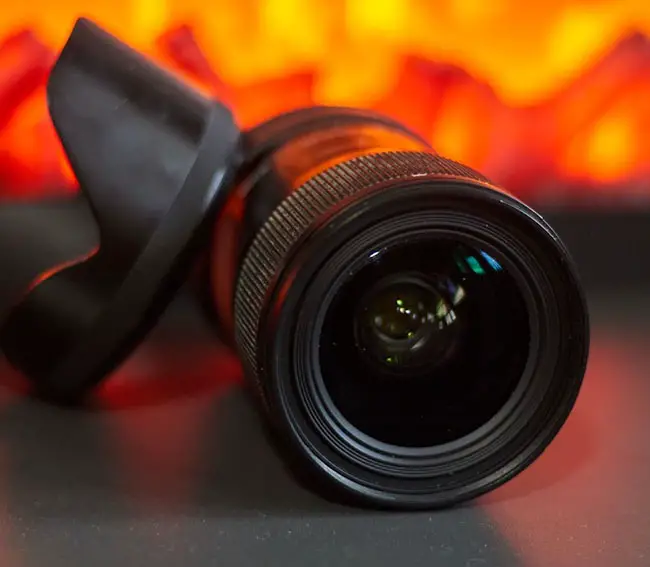
![Sigma 18-35mm f/1.8 DC HSM Art [Best Lens for Canon Rebel T6]](http://www.lapseoftheshutter.com/wp-content/uploads/2022/08/Sigma-18-35mm-f1.8-DC-HSM-Art.jpg)
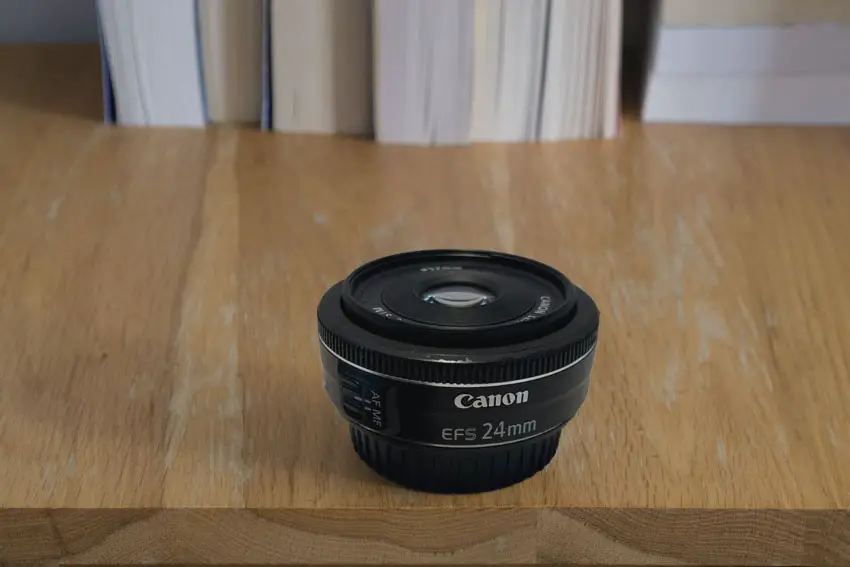
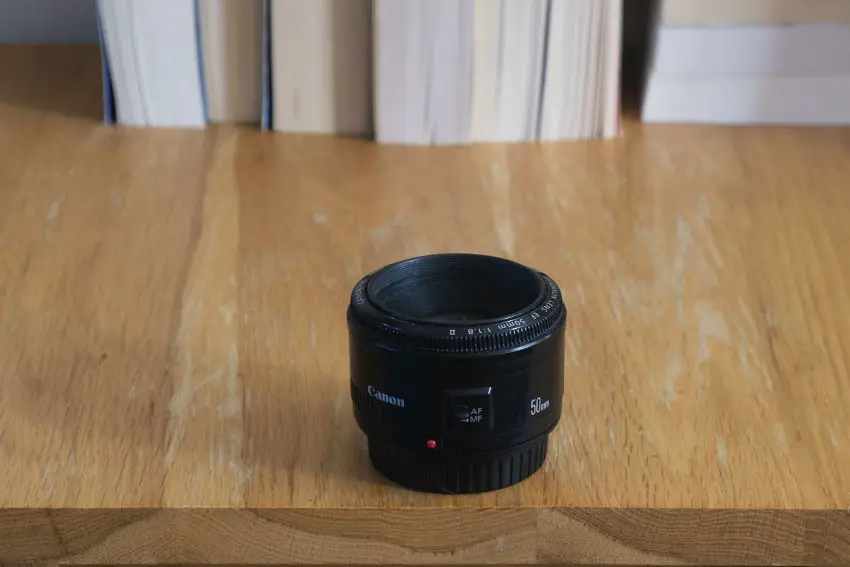
![Tamron 18-200mm f/3.5-6.3 Di II VC [Zoom Lens for Canon Rebel T6]](http://www.lapseoftheshutter.com/wp-content/uploads/2022/10/Tamron-AF-18-200mm-F3.5-6.3-Di-II-VC-lens.jpg)
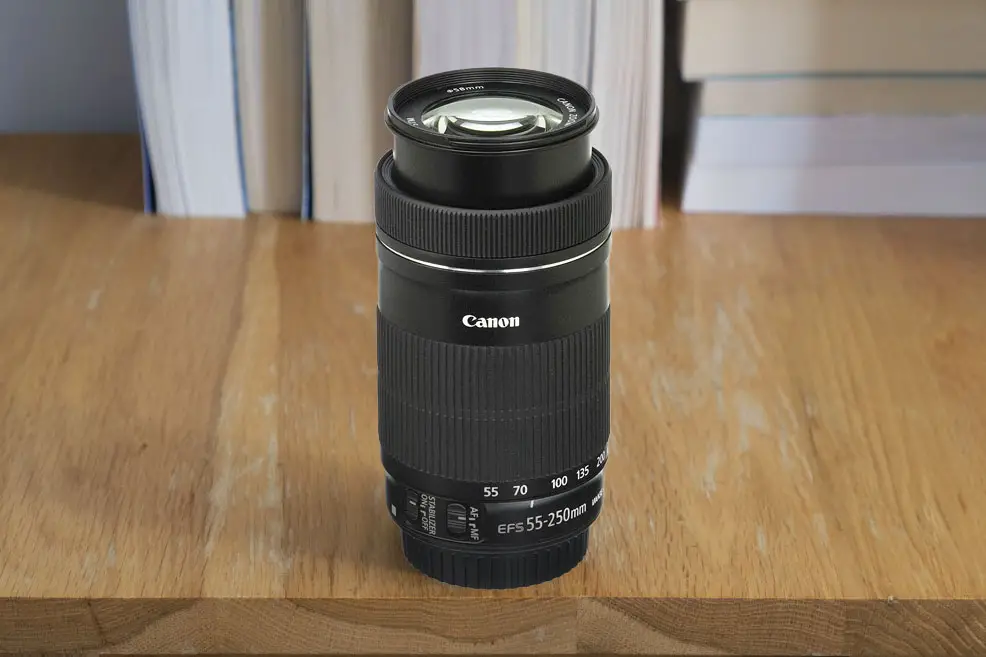
![Tamron 18-400mm f/3.5-6.3 Di II VC HLD [Telephoto Lens for Canon Rebel T6]](http://www.lapseoftheshutter.com/wp-content/uploads/2022/10/Tamron-18-400mm-f3.5-6.3-DiII-VC-HLD-lens.jpg)
![Canon EF-S 10-18mm f/4.5-5.6 IS STM [Wide Angle Lens for Canon Rebel T6]](http://www.lapseoftheshutter.com/wp-content/uploads/2022/10/Canon-EF-S-10-18mm-f4.5-5.6-IS-STM-lens.jpg)
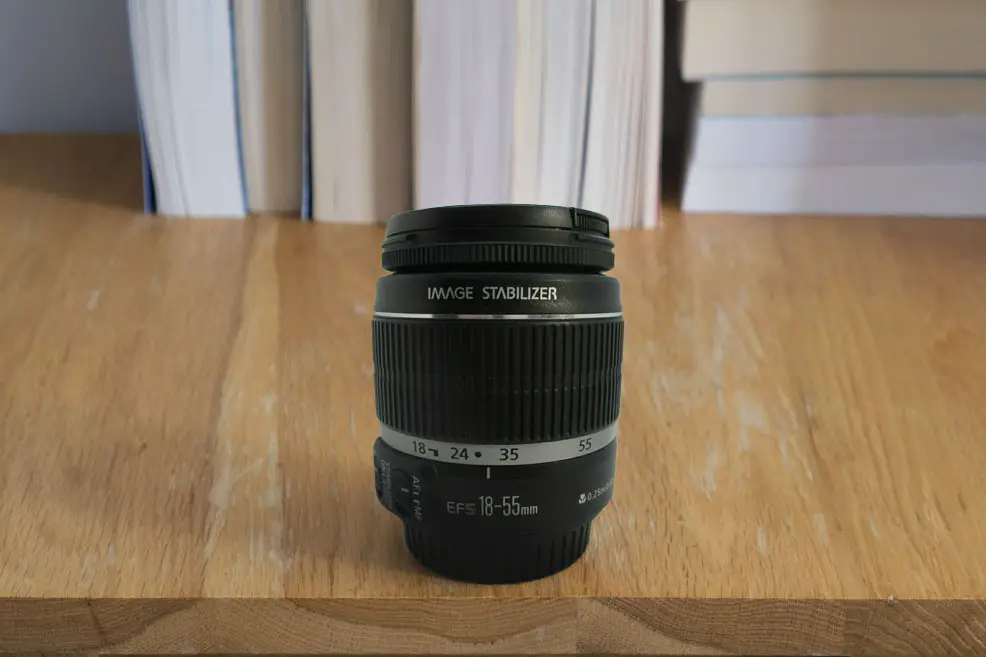
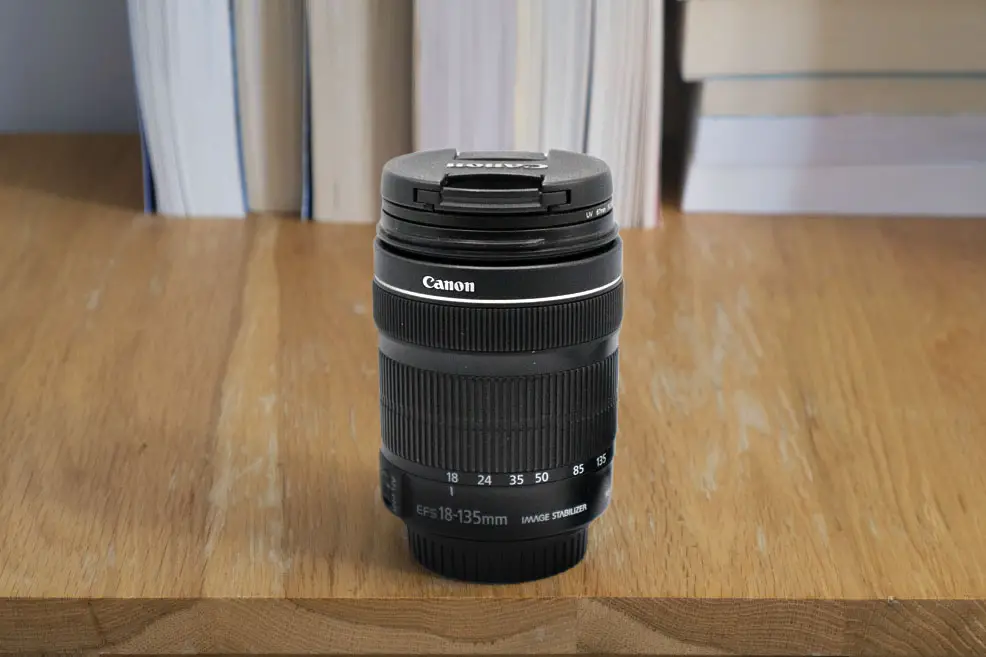
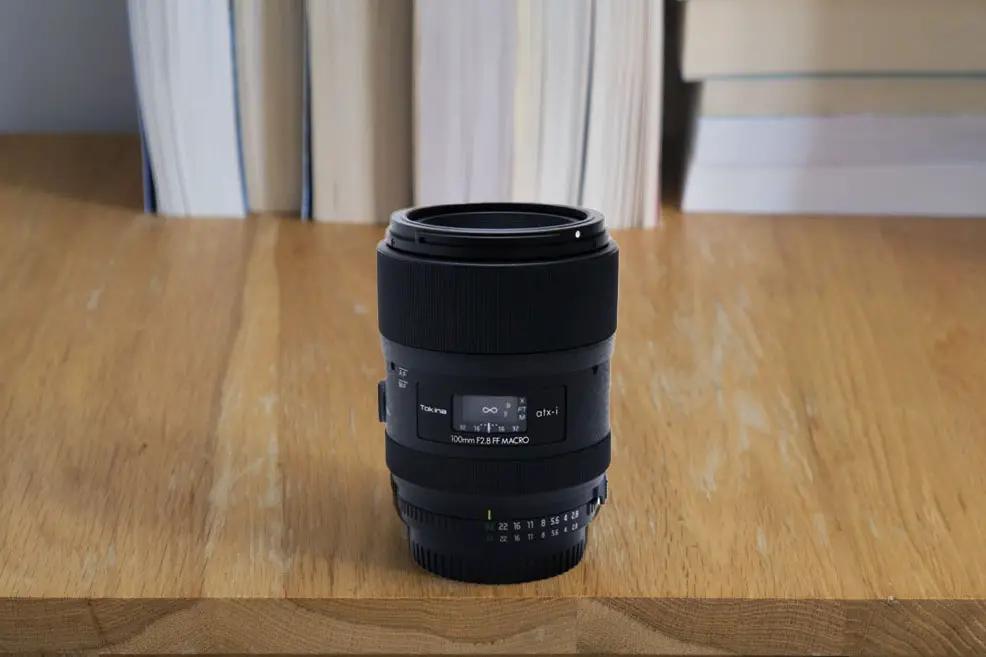


![Tamron 18-200mm f/3.5-6.3 Di II VC [Zoom Lens for Canon Rebel T6]](https://www.lapseoftheshutter.com/wp-content/uploads/2022/10/Tamron-AF-18-200mm-F3.5-6.3-Di-II-VC-lens.jpg)

![Tamron 18-400mm f/3.5-6.3 Di II VC HLD [Telephoto Lens for Canon Rebel T6]](https://www.lapseoftheshutter.com/wp-content/uploads/2022/10/Tamron-18-400mm-f3.5-6.3-DiII-VC-HLD-lens.jpg)
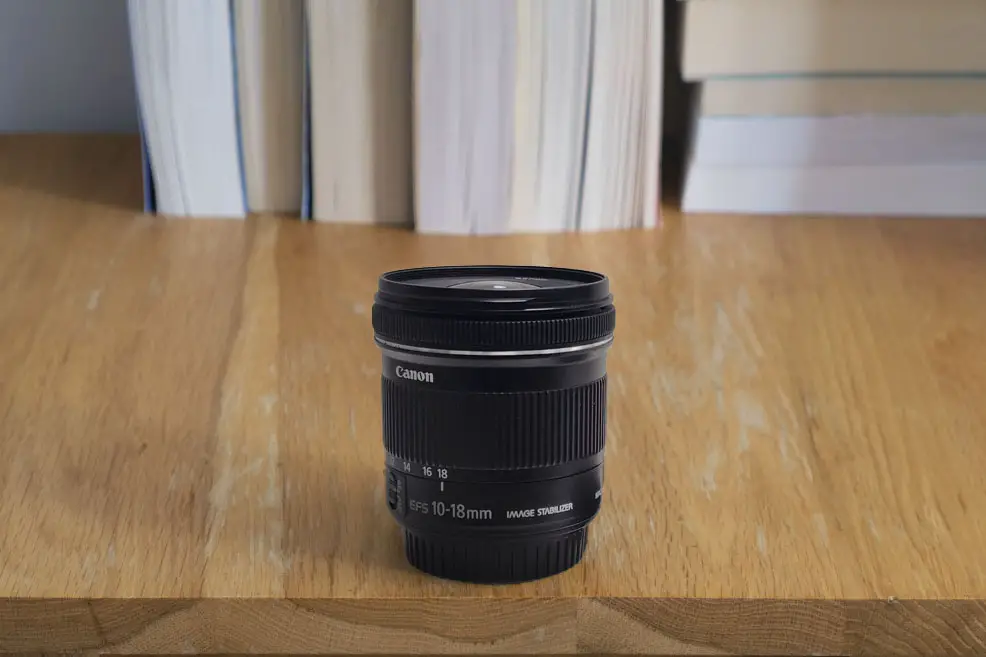





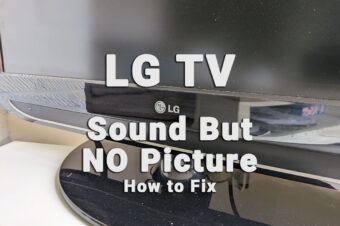



Leave a Reply